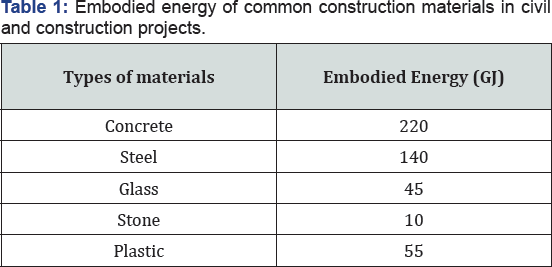Critical Review of the Greenhouse Gas and Environmental Impact of Common Materials in Civil and Construction Projects: Present and Alternatives- Juniper Publishers
Juniper Publishers- Journal of Civil Engineering
Abstract
Climate change due to the greenhouse gas emissions
from anthropogenic and natural activities has become a major concern
internationally.
The civil and construction sectors have been identified as one of the
major contributors of global environmental impact due to their high-
energy consumption. Embodied energy is used to provide a full picture of
the energy consumption of the materials from the extraction and
deconstruction. This paper is to conduct a critical review of a
high-embodied energy artificial mixture, concrete, one of the most
commonly used materials in construction industry and suggest the latest
practices to minimize the adverse impacts of its application in civil
and construction project.
Keywords: Environmental impact; Embodied energy; Concrete; Life cycle
Introduction
Climate change due to the greenhouse gas emissions
from anthropogenic and natural activities has become a major concern
internationally. Rapid urbanization, continuous industrialization and
improved living standards have inflated energy consumption in recent
years. Construction works require vast quantities of materials and the
consumption of virgin resources, and this releases deleterious pollutant
emission to the biosphere. Globally, the construction industry produces
high levels of pollution energy consumed (and concomitant greenhouse
gas emission) during extraction, processing and transportation of raw
materials. For example, the energy used to manufacture and transport
construction materials represents nearly 10-15% of all primary energy
used in developed countries such as the United Kingdom, whereas 50% of
all energy consumed is attributable to the operational stage of the
buildings/ assets Thormark [1].
The embodied energy aims to measure the total energy necessary for an
entire product (or material) life-cycle that is, extraction, production,
transportation, installation and deconstruction/ decomposition. The use
of high embodied energy materials such as concrete, cement and
aluminum, must comply with the environmental friendly material concept.
Opportunities to reduce embodied energy and greenhouse gas emissions
occur during at various stages of the building's life cycle, namely: (a)
design, (b) construction and (c) operation stages. This paper seeks to
conduct a critical review of high embodied energy and greenhouse gas
emissions of the construction material 'concrete' and suggest the latest
practices to minimize the adverse impact of its application in civil
engineering and construction projects.
Reinforced concrete
For civil engineering and construction projects,
reinforced concrete is a common 'composite' construction material that
is stronger, durable and less likely to fail under load CSIRO [2]. Reducing embodied energy used in concrete can play a significant role in achieving sustainable construction.

Design stage: In the design stage, adjusting traditional concrete mixtures can decrease the embodied energy. Tosic et al. [3]
stated that post-tensioned slabs induced less embodied energy than
traditional reinforced concrete slabs. The adoption of fly ash in
replacing traditional cement elements can also help to reduce embodied
energy inherent within concrete. Portland cement can be replaced with
less carbon-intensive materials such as Pulverized Fuel Ash (PFA) and
Ground Granulated Blast furnace Slag (GGBS). PFA can replace up to 40%
of cement in typical construction and engineering applications Hammond
& Jones [4].
A filler slab is another option for reducing the weight of structural
elements, which are solid reinforced concrete slabs with partial
replacement of the concrete in the tension zone by a filler material.
Lightweight and inert such as low-grade Mangalore tiles, Thermopolis
Burnt Clay Bricks, hollow concrete blocks, stabilized mud blocks can be
used as filler materials Reddy & Jagadish [5]. At least 30% of concrete is saved using the filler slab technique.
Construction stage: Transportation is a major
contributor to the embodied energy of construction materials. A concrete
truck normally emits not less than 100x10-6kg of carbon dioxide for
transporting each kg of concrete over one km distance. The emission is
increased if small trucks or Lorries are used. Using locally sourced
materials will reduce the embodied energy during the construction stage
by reducing carbon emissions from transportation. Locally sourced
materials also include materials salvaged on site. Concrete can be
recycled as an aggregate after the demolition of existing buildings.
Under the strict control of the recycled aggregate, it can be used to
replace part of the natural aggregate Tosic et al. [3] and can minimize the transportation of natural aggregate from overseas.
Operational stage: During the operational
stage, keeping regular maintenance can effectively enhance the lifespan
of the building's structural elements. Proper maintenance to minor
concrete defects should be carried out as soon as possible once defects
are identified. For example, using spraying concrete techniques for
repairing the defective concrete can provide a high density and low
permeability cover to the existing concrete structure Sprayed Concrete
Association [6].
When compared to demolition and reconstruction, a vast amount of raw
material (such as cement) can be saved, thus reducing embodied energy.
Conclusions
The civil and construction sectors have been
identified as one of the major contributors of global environmental
impact due to their high-energy consumption. Reducing embodied energy in
construction materials through recycling and reuse of materials,
balancing the use of the materials and proper maintenance to the
structural elements can make a considerable improvement to the energy
use during the lifecycle of civil engineering and construction projects.
For More Open Access Journals Please Click on: Juniper Publishers
Fore More Articles Please Visit: Civil Engineering Research Journal


Comments
Post a Comment